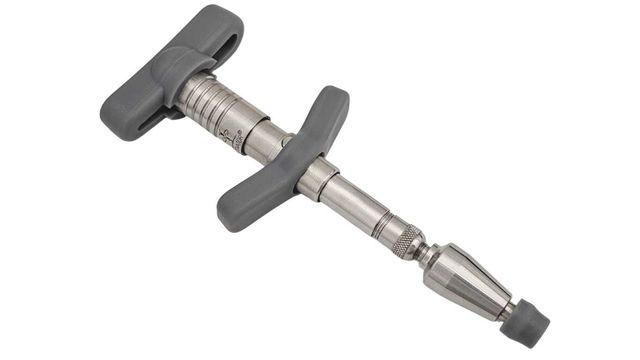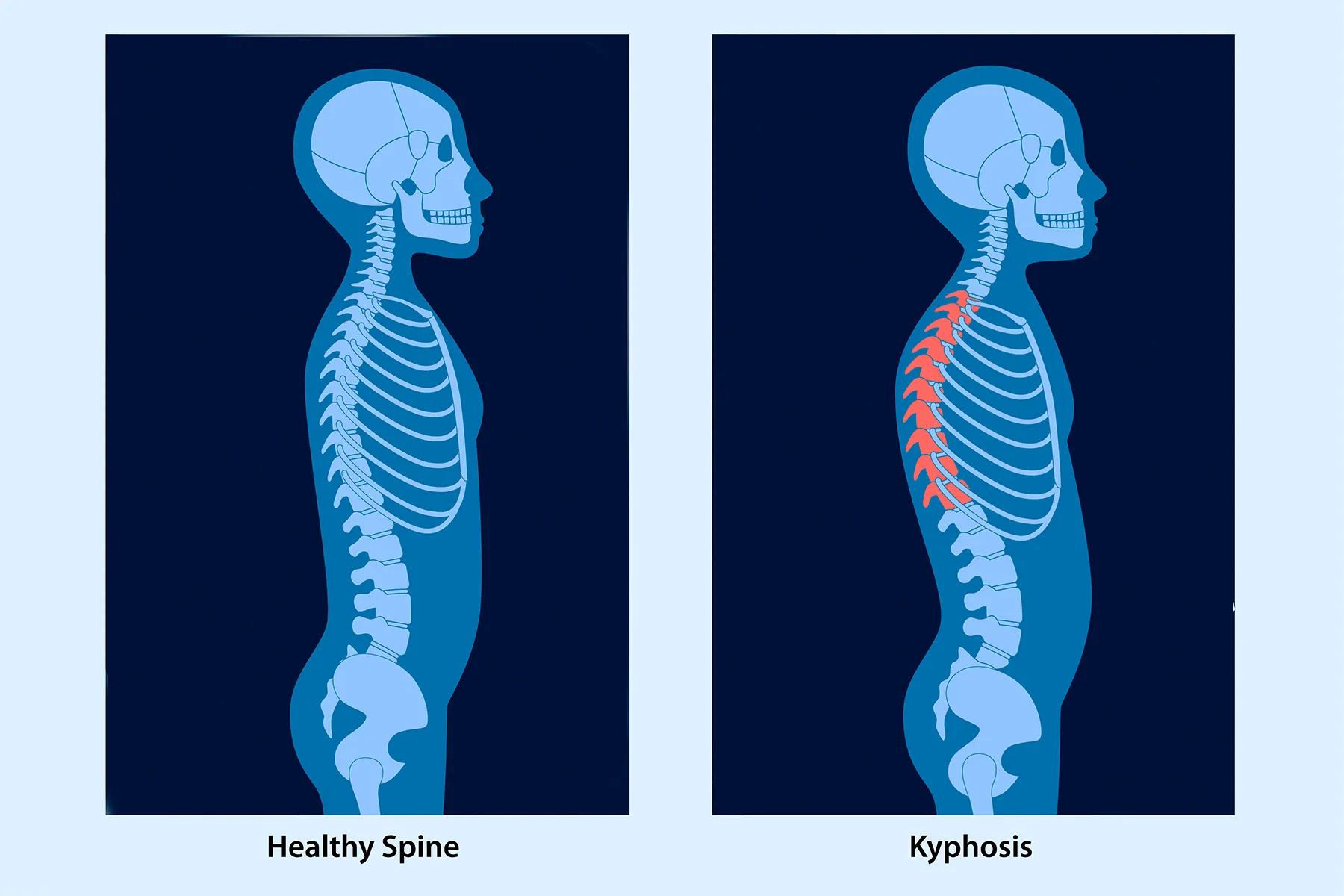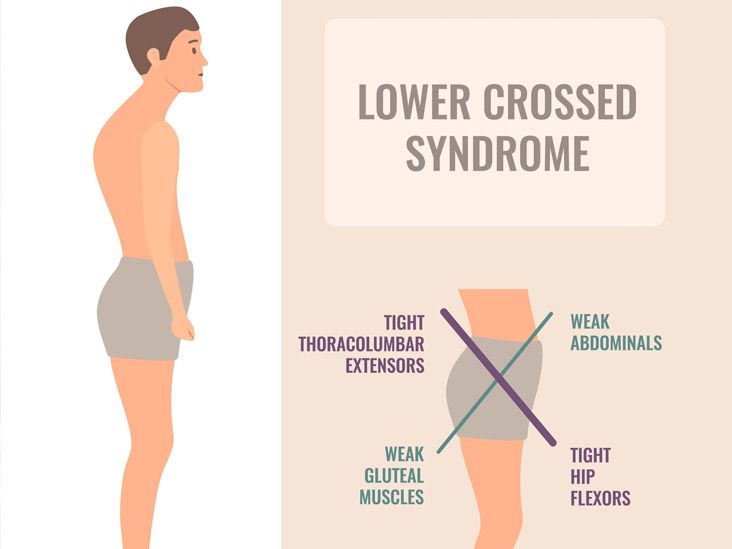
When most people picture a chiropractic adjustment, they imagine a manual adjustment—the quick, precise movement of a chiropractor’s hands creating that signature “pop.” But there’s another technique that’s just as effective, and in many cases, even more comfortable for patients: the Activator. This method uses a small handheld tool called the Activator Adjusting Instrument to deliver safe, gentle, and targeted adjustments. While it might look simple, this little spring-loaded device packs a powerful punch when it comes to improving spinal health and reducing pain. In this post, we’ll break down what the Activator is, why chiropractors use it, how it works, and who can benefit most from this technique.

When you hear the word kyphosis , you might picture someone hunched over with poor posture. But this spinal condition is a lot more interesting—and more common—than most people realize. Kyphosis happens when there’s an exaggerated forward rounding of the upper back. While a little rounding is normal, too much can cause pain, stiffness, and even affect breathing in severe cases. The good news? With the right awareness and care, many people can manage it effectively. Here are six things you may not have known about kyphosis:

Chiropractic care is often surrounded by myths and misconceptions, some of which may lead people to shy away from seeking care or fully understanding its benefits. From concerns about safety to doubts about its effectiveness, many misconceptions persist about chiropractic care. However, as the field of chiropractic continues to grow, research and evidence-based practices help to dispel these myths. In this blog post, we’ll explore some of the most common misconceptions about chiropractic care, and provide evidence to clarify the truths behind them.

Children are constantly growing, learning, and exploring the world around them. From their first steps to their time spent in school and on the playground, their bodies undergo continuous physical stress and development. While pediatric health often focuses on nutrition, vaccinations, and regular checkups, spinal health is sometimes overlooked. Chiropractic care offers a safe, effective way to support proper growth, posture, and overall well-being in children.

If you’ve ever felt nagging lower back pain, persistent tightness in your hips, or a sense of imbalance between your core and legs, you might be dealing with something called Lower Cross Syndrome (LCS). While it sounds complex, LCS is actually a common muscular imbalance that many people—especially those with sedentary jobs or intense training routines—experience. The good news? It’s manageable, preventable, and treatable. And Peak Performance, your local chiropractic and massage therapy team, can be part of the solution.

As we age, maintaining good mobility and quality of life becomes a top priority. While physical changes like joint stiffness, muscle weakness, and decreased flexibility are a natural part of the aging process, there are ways to manage these changes and maintain an active, fulfilling lifestyle. Chiropractic care for seniors can play a vital role in enhancing mobility, reducing pain, and improving overall well-being. In this blog post, we’ll explore the many benefits of chiropractic care for seniors and how it can help you age gracefully while maintaining your independence. 1. Understanding Chiropractic Care Chiropractic care focuses on the relationship between the spine and the nervous system, emphasizing manual adjustments to the spine and joints to alleviate pain, improve mobility, and support overall health. Chiropractors are highly trained to diagnose and treat musculoskeletal conditions, particularly those involving the spine, joints, and soft tissues. For seniors, chiropractic care is not just about alleviating pain; it's also about improving function, preserving mobility, and supporting the body’s natural ability to heal itself. Chiropractic adjustments are a safe, non-invasive way to promote spinal health, improve posture, and help manage the discomfort that often comes with aging. 2. The Aging Body: Common Challenges for Seniors As we age, the body undergoes several natural changes that can impact mobility and quality of life. These changes often include: Decreased Flexibility: As muscles and connective tissues lose elasticity, seniors often experience joint stiffness and reduced range of motion. This can make simple tasks like bending, reaching, and walking more difficult. Osteoarthritis: This common condition involves the gradual breakdown of cartilage in the joints, leading to pain, swelling, and decreased function. It can affect various areas of the body, including the knees, hips, and spine. Postural Changes: Over time, poor posture habits can lead to misalignments in the spine, contributing to back pain, muscle tension, and limited mobility. Falls and Balance Issues: As the body’s balance system weakens with age, seniors are at higher risk of falls. Chiropractic adjustments can help improve balance and reduce the risk of falls by promoting proper spinal alignment and improving joint function. 3. How Chiropractic Care Benefits Seniors Chiropractic care offers a variety of benefits for seniors looking to maintain mobility and quality of life. Below are some of the key advantages: Pain Relief One of the most common reasons seniors seek chiropractic care is to address chronic pain. Whether it’s back pain, neck pain, arthritis, or headaches, chiropractic adjustments can help alleviate discomfort by restoring proper alignment to the spine and joints. This helps to reduce pressure on nerves, improve circulation, and promote the body’s natural healing processes. Improved Mobility and Flexibility Chiropractic adjustments can improve joint mobility, helping seniors regain flexibility and increase their range of motion. This is especially beneficial for individuals suffering from arthritis or age-related stiffness. By restoring alignment and function to the joints, chiropractic care can reduce pain and improve overall movement, making it easier to perform daily activities and enjoy recreational pursuits. Enhanced Posture As we age, our posture tends to decline, leading to slumping, rounded shoulders, or forward head posture. This can result in back and neck pain, muscle fatigue, and limited mobility. Chiropractic adjustments help realign the spine and improve posture, reducing strain on the muscles and joints. Better posture can also increase energy levels and reduce discomfort, allowing seniors to feel more comfortable and confident in their daily lives. Injury Prevention and Fall Risk Reduction Chiropractic care can help improve balance, coordination, and overall physical function. This is especially important for seniors who may have an increased risk of falls. Through regular adjustments, chiropractic care helps keep the nervous system functioning optimally, enhancing balance and coordination. Additionally, chiropractic care can identify and treat musculoskeletal imbalances that may contribute to falls, such as hip misalignments or weakened muscles. Stress Relief and Better Sleep Chronic pain and tension can increase stress and make it difficult to get a good night’s rest. Chiropractic care can help reduce muscle tension and alleviate pain, leading to a greater sense of relaxation and reduced stress. By improving spinal alignment and supporting the body’s natural healing processes, chiropractic adjustments can promote better sleep and improve overall emotional well-being. Support for Other Health Conditions Chiropractors don’t just treat musculoskeletal issues. They can also help seniors manage a variety of other health conditions, such as: Headaches: Chiropractic adjustments can reduce the frequency and severity of tension headaches and migraines by improving spinal alignment and reducing muscle tension. Digestive Issues: Misalignments in the spine can affect nerve function, leading to digestive issues like constipation. Chiropractic care can help improve nerve communication, promoting healthy digestion. Sciatica: Many seniors experience sciatica, which is a sharp pain that radiates down the leg. Chiropractic adjustments can alleviate pressure on the sciatic nerve and reduce pain. 4. Safety and Considerations for Seniors Chiropractic care is generally considered safe for seniors, but as with any medical treatment, it’s important to consider individual health conditions. Before beginning chiropractic care, seniors should consult with their primary care provider to ensure that chiropractic adjustments are appropriate for their specific needs. Some seniors may have certain health conditions, such as osteoporosis, severe arthritis, or recent surgeries, that require modifications to their chiropractic treatment plan. Chiropractors are skilled at tailoring their techniques to accommodate these conditions and ensure that the care provided is safe and effective. Additionally, seniors should choose a chiropractor who is experienced in working with older adults. A knowledgeable chiropractor will understand the unique needs and concerns of seniors and will be able to develop a treatment plan that supports their health goals. 5. The Importance of Regular Care For seniors, chiropractic care is most effective when it is part of a regular maintenance routine. While one or two adjustments may provide temporary relief, regular visits to the chiropractor can help sustain improvements in mobility, pain levels, and overall health. Chiropractic care can complement other health practices such as physical therapy, exercise, and a healthy diet, allowing seniors to maintain an active and independent lifestyle for years to come. Conclusion Chiropractic care is an excellent option for seniors looking to maintain mobility, manage pain, and enhance their overall quality of life. With its emphasis on spinal health, mobility, and pain relief, chiropractic care can help seniors stay active, improve their posture, reduce the risk of falls, and support their overall well-being. By working closely with a chiropractor who understands the unique needs of older adults, seniors can enjoy greater mobility, independence, and vitality well into their golden years. If you’re a senior looking to improve your mobility or address age-related discomfort, consider reaching out to a chiropractor to learn how chiropractic care can support your health and enhance your quality of life. Bethany Wolcott D’Youville Chiropractic ‘26

Pregnancy is an exciting and transformative journey, but it can also bring significant physical challenges. As a mother-to-be, your body undergoes rapid changes to accommodate the growing baby, often leading to discomfort, aches, and postural shifts. Chiropractic care can be a safe and effective way to manage these changes, helping to reduce pain, improve mobility, and prepare the body for a smoother delivery. How Pregnancy Affects the Spine and Pelvis During pregnancy, the body experiences a range of physiological changes, including: Postural Adjustments – As the baby grows, the center of gravity shifts forward, increasing stress on the lower back and pelvis. Hormonal Changes – The hormone relaxin loosens ligaments in preparation for childbirth, which can sometimes lead to instability and discomfort in the spine and joints. Increased Spinal Curvature – The natural curve of the lower back becomes more pronounced, which can contribute to pain and muscle tightness. Pelvic Misalignment – Changes in pelvic alignment can affect the baby’s positioning and potentially lead to a more challenging labor and delivery. Chiropractic care offers a drug-free approach to managing these changes, ensuring the spine and pelvis remain properly aligned for a more comfortable pregnancy. Benefits of Chiropractic Care During Pregnancy 1. Relieves Back, Hip, and Pelvic Pain Many pregnant women experience lower back and hip pain due to the extra weight and shifting posture. Chiropractic adjustments can help realign the spine and relieve pressure on the joints and nerves, providing much-needed relief. 2. Improves Pelvic Balance and Baby Positioning Pelvic misalignment can restrict the amount of space available for the baby to move into the ideal head-down position for birth. Chiropractors trained in the Webster Technique specialize in adjusting the pelvis to create optimal alignment, reducing the likelihood of breech positioning and promoting a smoother delivery. 3. Reduces the Risk of Sciatic Nerve Pain As the uterus expands, it can put pressure on the sciatic nerve, leading to sharp, radiating pain down the lower back, hips, and legs. Chiropractic adjustments help relieve this pressure, reducing discomfort and improving mobility. 4. Enhances Nervous System Function The nervous system controls nearly every function in the body, including those crucial for pregnancy and childbirth. By ensuring proper spinal alignment, chiropractic care helps the nervous system communicate more effectively, supporting overall well-being for both mother and baby. 5. Promotes Better Posture and Balance The additional weight and shifting center of gravity can lead to postural imbalances. Regular chiropractic adjustments help maintain proper posture, reducing strain on muscles and joints. 6. May Contribute to an Easier Labor and Delivery A properly aligned pelvis allows for a smoother labor process by ensuring that the baby has ample space to descend. Studies suggest that chiropractic care may help reduce labor times and the need for medical interventions during delivery. Is Chiropractic Care Safe During Pregnancy? Yes! Chiropractic care is considered safe for most pregnant women when performed by a qualified practitioner. Chiropractors use gentle, pregnancy-specific techniques that avoid unnecessary pressure on the abdomen. Many offices also provide specialized tables and pillows to accommodate the growing belly comfortably. It is always a good idea to consult with your obstetrician or midwife before beginning chiropractic care, especially if you have any pregnancy complications or high-risk factors. When Should You Start Chiropractic Care During Pregnancy? There is no wrong time to start chiropractic care during pregnancy. Some women begin care in the first trimester to help with early postural changes, while others seek treatment later on to address discomfort as their pregnancy progresses. Regular adjustments throughout pregnancy can provide ongoing relief and support. Additional Ways to Support a Healthy Pregnancy Chiropractic care works best when combined with other wellness strategies, including: Prenatal Exercise – Activities like walking, swimming, and prenatal yoga help maintain strength and flexibility. Proper Hydration – Staying hydrated supports spinal health and reduces muscle stiffness. Supportive Footwear – Wearing shoes with proper arch support helps distribute weight evenly and reduces lower back pain. Prenatal Massage – Massage therapy can complement chiropractic adjustments by reducing muscle tension and promoting relaxation. Preparing for Postpartum Recovery Chiropractic care doesn’t stop after delivery. Postpartum adjustments can help realign the spine, support recovery, and address any lingering discomfort from pregnancy and labor. Many new mothers find that chiropractic care helps them regain mobility and energy, making it easier to care for their newborns. Final Thoughts Pregnancy is a time of immense physical change, but it doesn’t have to be uncomfortable. Chiropractic care offers a safe and natural way to support your body as it adapts to pregnancy, helping to relieve pain, improve pelvic alignment, and even contribute to an easier delivery. At Peak Performance, our chiropractors have experience working with expecting mothers and use gentle, pregnancy-friendly techniques to provide the best care possible. If you’re interested in experiencing the benefits of chiropractic care during pregnancy, schedule a consultation with us today! Bethany Wolcott D’Youville Chiropractic ‘26

Massage therapy is widely known for its relaxation benefits, but there are many misconceptions that can cause confusion and prevent people from fully enjoying its therapeutic effects. As a medical massage office, we focus on evidence-based practices that can aid in pain relief, mobility, and overall well-being. In this blog, we’ll clear up some common myths about massage therapy to help you better understand its real benefits. Myth 1: Massage Is Only for Relaxation While many people associate massage with a day at the spa or a way to unwind after a stressful week, the truth is, massage therapy has a wide range of therapeutic benefits beyond relaxation. Medical massage techniques are often used to target specific issues like muscle tension, joint pain, sports injuries, and chronic conditions like arthritis. Trigger point therapy, deep tissue massage, and myofascial release can provide pain relief and promote healing in a way that goes beyond mere relaxation. In fact, massage therapy can be an essential part of a comprehensive treatment plan for conditions such as sciatica, tendonitis, and TMJ disorder. Whether you're recovering from an injury or managing ongoing discomfort, therapeutic massage can be a key tool in improving your quality of life. Myth 2: Massage Hurts, So It Must Be Working A common misconception is that if a massage isn’t painful, it isn’t effective. Many people assume that deep pressure is the only way to treat muscle tightness and tension. While deep tissue massage can indeed provide relief for some, it doesn't have to be a painful experience to be effective. Massage therapy should always be tailored to the individual. Some people may need deeper pressure to target tight muscles, while others may find that a gentler technique is more effective. It’s important to communicate with your massage therapist about your comfort level. The right massage should provide relief without unnecessary discomfort. Painful massage can lead to muscle bruising or aggravate existing injuries, so always inform your therapist about any discomfort during the session. Myth 3: Massage Is Just for Muscles While massage therapy is commonly thought of as a way to work on muscles, it also benefits other parts of the body, including the nervous system, fascia, and connective tissues. Fascia, the thin layer of connective tissue that surrounds muscles and organs, can become tight and restricted due to stress or injury. A skilled massage therapist can help release these restrictions and improve mobility. Additionally, massage can help reduce stress levels, lower blood pressure, and improve circulation, contributing to overall health beyond the muscles. Furthermore, massage therapy can have a positive impact on the nervous system. It has been shown to reduce the body's fight-or-flight response, leading to lower levels of cortisol (the stress hormone) and increased production of endorphins, which are natural pain relievers. Myth 4: Massage Is a One-Time Fix for Pain Another myth is that a single massage will completely eliminate pain or stiffness. While massage therapy can offer significant relief, especially for acute muscle tension, it’s not always a one-time fix for chronic conditions. In most cases, regular massage therapy sessions can help maintain progress and manage ongoing issues. For instance, if you suffer from lower back pain, a single massage may provide some relief, but regular treatments over time are often necessary to keep the muscles relaxed and prevent the pain from returning. This is why massage therapy is often combined with other treatments, like chiropractic care and physical therapy, to create a more comprehensive approach to managing pain and improving function. Additionally, it’s important to follow any recommendations from your licensed massage therapist, such as stretching or strengthening exercises, to maintain the benefits of your massage. Proper self-care and a consistent routine can help keep pain at bay. Myth 5: Massage Is Only for Luxurious Settings While it’s true that many people think of massages as something reserved for spas or luxury hotels, medical massage is available in various settings, including chiropractic offices, physical therapy clinics, and wellness centers. These massages are specifically tailored to address therapeutic needs and focus on improving health outcomes. In a medical massage setting, the goal is not only to relax but to target specific problem areas and treat musculoskeletal issues in a clinical environment. Whether you’re dealing with an injury, recovering from surgery, or managing a chronic condition, a medical massage therapist can work with you to create a treatment plan that addresses your unique needs. Myth 6: Massage Is Only for People with Pain or Injuries Many people think massage therapy is only for those experiencing pain or recovering from an injury. While massage is certainly beneficial for these conditions, it can also be helpful for people who don’t have any immediate discomfort. Massage can be a great way to maintain overall health and well-being. It can reduce stress, improve sleep, and increase circulation, even for individuals who are not in pain. Regular massage therapy can also enhance flexibility and promote relaxation, making it an excellent addition to anyone’s self-care routine. Myth 7: You Don’t Need to Talk to Your Therapist During Your Massage While it’s common to think that you should just lay back and relax in silence, communicating with your massage therapist during the session is crucial for achieving the best results. Every person’s body is different, and it’s important to discuss your preferences, comfort level, and any areas of tension or discomfort. If you experience any pain during the massage, let your therapist know so they can adjust their technique. Similarly, if you prefer a lighter touch or deeper pressure, this should be communicated as well. The more information your therapist has, the better they can customize the treatment to suit your needs. Myth 8: Massage Should Always Be Done After Exercise Although many people associate massage with post-workout recovery, it’s not always necessary to wait until after exercise to book a session. While post-exercise massage can help reduce muscle soreness and improve recovery, massage therapy can also be beneficial before a workout. A pre-workout massage can help warm up the muscles, increase blood flow, and improve flexibility, which can reduce the risk of injury during physical activity. If you're preparing for a long run, heavy lifting, or any other strenuous activity, a massage can help loosen up tight muscles and get your body ready for action. Myth 9: Massage Is Too Expensive Some people may avoid massage therapy because they assume it’s too expensive. While the cost of massage can vary depending on the type of therapy and the length of the session, it typically ranges from $50-$150. Additionally, some insurance plans may cover massage therapy or offer discounts. When you consider the long-term benefits of massage therapy, such as improved mobility, reduced pain, and a better quality of life, the cost becomes more of an investment in your overall health. Conclusion Massage therapy is a powerful tool in the realm of pain management, injury recovery, and general wellness. By debunking these common myths, we hope to help you gain a better understanding of what massage therapy can really offer. Whether you’re seeking relief from chronic pain or simply want to improve your overall well-being, massage therapy can be an effective and valuable part of your health care routine. At Peak Performance here in Buffalo, NY, we focus on evidence-based treatments tailored to your individual needs. If you’re curious about how massage therapy can benefit you, don’t hesitate to reach out to our office! Bethany Wolcott D’Youville Chiropractic ‘26

When people think of chiropractic care, they often associate it with relieving back pain, easing joint tension, or improving posture. And while those benefits are real and well-documented, there’s another layer to the story—one that’s often overlooked: chiropractic care can positively influence mental health . The relationship between the body and the mind is more than just a wellness buzzword. It’s a scientifically supported connection that explains how physical health and mental well-being are deeply intertwined. And since the nervous system is the command center for both, it makes sense that optimizing its function can support not just how your body feels, but also how your mind copes, reacts, and heals. Let’s dive into how chiropractic care supports mental health—and why it might be a game-changer for your mood, stress levels, and sleep patterns. How Chiropractic Care Supports Mental Health Chiropractic care isn’t just about cracking backs or “fixing” posture—it’s about restoring alignment and balance to the body. This, in turn, reduces strain on the nervous system, which is responsible for regulating stress responses, emotional health, and sleep cycles. Here are just a few ways chiropractic care can promote better mental health: 1. Reducing Stress and Anxiety Let’s be honest—modern life is stressful. From work emails to traffic jams to managing daily responsibilities, stress can take a toll on your body and your brain. When the spine is misaligned, it can cause tension in the musculoskeletal system and disrupt the autonomic nervous system, which governs your stress response. Chiropractic adjustments help by: Easing physical tension in the muscles and joints. Supporting healthy cortisol levels by calming the nervous system. Encouraging the parasympathetic “rest and digest” response, which counters the effects of chronic stress. Many patients report feeling lighter, calmer, and more at ease after an adjustment—often describing the experience as mentally clarifying or emotionally refreshing. 2. Improving Sleep Quality If you've ever struggled with poor sleep, you know how quickly it can impact your mood, memory, focus, and overall sense of well-being. Poor sleep is linked to anxiety, depression, irritability, and even chronic illness. Chiropractic care supports better sleep by: Reducing musculoskeletal discomfort that keeps people tossing and turning. Enhancing circulation and reducing nerve interference, which helps the body reach a more relaxed state. Supporting melatonin regulation by improving nervous system function. Even small improvements in sleep quality can lead to big gains in mental clarity and emotional resilience. 3. Boosting Mood and Emotional Balance The spine houses the central nervous system—the superhighway of communication between the brain and the rest of the body. When misalignments interfere with nerve function, that communication breaks down. This can contribute to everything from poor immune function to emotional instability. By correcting spinal misalignments, chiropractic care may: Improve neurotransmitter regulation. Support endorphin release. Reduce symptoms associated with low mood and mental fatigue. It’s not a substitute for therapy or medication when needed, but it can serve as an effective complement to your broader mental wellness plan. Chiropractic Care and the Nervous System The nervous system is the MVP when it comes to regulating both physical and emotional states. It’s made up of the brain, spinal cord, and all the nerves that branch throughout the body. When the spine is in proper alignment, nerve signals can flow freely, ensuring that all systems—from digestion to hormone balance to emotional regulation—are working together efficiently. Here’s what happens when you take pressure off the nervous system with chiropractic care: Clearer brain-body communication , reducing irritability and mental fog. Better circulation and oxygenation to the brain, which can improve focus, cognition, and energy. Greater endorphin release , promoting a natural, feel-good mood lift. Think of it as untangling a knotted headphone cord. Once everything is in alignment, the signals are clearer—and the whole system works better. Conditions That May Benefit from Chiropractic Care While chiropractic care is not a direct treatment for mental health disorders like depression, anxiety, or PTSD, it can support the physical side of healing. Many mental health symptoms are accompanied (or worsened) by physical tension, fatigue, and poor sleep. Here are a few examples of conditions that may benefit from chiropractic care: Chronic Stress If you’re stuck in a cycle of stress, chiropractic adjustments can help reset your system, improving your ability to cope with daily challenges. Depression and Anxiety Patients often report a greater sense of well-being and calm after adjustments. These small wins can help support a more positive mindset. PTSD Although PTSD should always be addressed with trauma-informed therapy, chiropractic care can play a supportive role by reducing physical symptoms like tightness, pain, and sleep disruption. A Natural Approach to Mental Well-Being Chiropractic care is often most effective when used alongside other lifestyle strategies aimed at improving emotional resilience and brain health. Consider these powerful wellness allies: 1. Exercise Movement isn’t just for muscles—it's a proven mood booster. Whether it’s walking, yoga, or hitting the gym, physical activity releases endorphins that combat stress and support mental clarity. 2. Nutrition Your gut and brain are in constant conversation. Fueling your body with nutrient-rich foods—especially omega-3s, lean proteins, and leafy greens—can positively affect mood, energy, and focus. 3. Mindfulness and Meditation Incorporating mindfulness techniques into your routine can help calm the mind and enhance the relaxing effects of chiropractic adjustments. A few minutes of deep breathing before bed or a short guided meditation after your appointment can make a big difference. 4. Massage Therapy Massage therapy works hand-in-hand with chiropractic care to ease muscle tension, reduce anxiety, and promote a sense of calm. Many patients find that combining the two results in longer-lasting relief and better mental clarity. What to Expect at Peak Performance At Peak Performance , we take a full-body approach to care—one that recognizes the deep connection between your spine, your nervous system, and your mental well-being. Whether you’re coming in for tension headaches, low back pain, or just feel like your body is "off," our chiropractors are here to listen, adjust, and support your whole health journey. We believe that when your body moves well, your mind follows. That’s why we focus on alignment, balance, and helping you feel better from the inside out. Taking the Next Step Toward Better Health If you’ve been feeling overwhelmed, out of sync, or just not quite like yourself, it might be time to consider how your spine and nervous system are playing a role. Chiropractic care isn’t a magic fix—but it can be a powerful tool in your wellness toolbox. Ready to experience the mind-body connection in action? Book an appointment with Peak Performance today and see how chiropractic care can help you move, feel, and think better—naturally. Bethany Wolcott D’Youville Chiropractic ‘26



